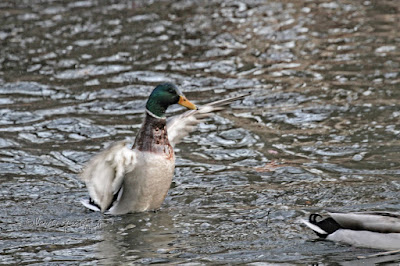The author, J.D. Salinger, died nine years ago (2010) on this day of 1-27. He was ninety-one years of age as he had recently celebrated his birthday (he was born on 1-1-1919).
My photos atop this entry are of a male and female Mallard duck (respectively) enjoying either the pond or the lake in Central Park and they are (along with the other Mallard images included within this posting) intended to be a tribute to him.
Central Park Mallards, as you may know are featured in Salinger's novel, The Catcher In The Rye.
Here are to passages from that novel (which have been included in my prior entries here on Blogger) where these ducks are referenced.
ONE (Holden Caulfield to Horowitz):
"I didn't want to start an argument. "Okay," I said. Then I thought of something, all of a sudden. 'Hey, listen,' I said. 'You know those ducks in that lagoon right near Central Park South? That little lake? By any chance, do you happen to know where they go, the ducks, when it gets all frozen over? Do you happen to know, by any chance?' I realized it was only one chance in a million.
"He turned around and looked at me like I was a madman. 'What're ya tryna do, bud?' he said. 'Kid me?'
"'No—I was just interested, that's all."'
"He didn't say anything more, so I didn't either. Until we came out of the park at Ninetieth Street. Then he said, 'All right, buddy. Where to?'"
TWO (Holden Caulfield to Horowitz):
"'The ducks. Do you know, by any chance? I mean does somebody come around in a truck or something and take them away, or do they fly away by themselves – go south or something?"'
"Old Horwitz turned all the way around and looked at me. He was a very impatient-type guy. He wasn't a bad guy, though.
"'How the hell should I know?"' he said.
"'How the hell should I know a stupid thing like that?"'
"'Well, don't get sore about it,"' I said. He was sore about it or something.
"'Who's sore? Nobody's sore."'
I stopped having a conversation with him, if he was going to get so damn touchy about it. But he started it up again himself. He turned all the way around again, and said, "'The fish don't go no place. They stay right where they are, the fish. Right in the goddam lake."'
[…] "'Listen,"' he said. "'If you was a fish, Mother Nature'd take care of you, wouldn't she? Right? You don't think them fish just die when it gets to be winter, do ya?"'
"'No, but – "'
"'You're goddam right they don't,"' Horwitz said, and drove off like a bat out of hell. He was about the touchiest guy I ever met. Everything you said made him sore. "
In any event, it seems that anytime I'm at The Lake or The Pond Central Park and encounter a Mallard...
... Salinger comes to my mind.
The same holds true when I encounter Mallards at The Jacqueline Kennedy Onassis Reservoir in CP.
By the way, according to a Central Park related web-page, "after smaller water bodies — such as the Pond — freeze over, ducks will begin the search for open water. If you don’t see them at the Harlem Meer or the Lake, you’ll find them at the Reservoir, where the water’s surface is usually too large to freeze. The Reservoir is a popular winter destination for birders looking to document waterfowl, as the population also includes migratory ducks (including ruddy and bufflehead ducks). In a collaborative survival move, ducks on the Reservoir will oftentimes swim together in a circle to bring food to the surface of the water.
While the Park’s animals shift gears to survive the winter frost, our work to maintain their natural habitat continues throughout the colder months. From scheduling construction projects around migratory bird season, to creating shallow waterbodies that promote a diverse aquatic population, the Conservancy’s landscape architects are mindful not only of the Park’s visitors, but of the wildlife that calls Central Park home. Visitors can also do their part to keep the animals safe by not feeding them. Together, we can ensure that Central Park provides a welcoming and sustainable environment for all, including the animals."
I always thought Salinger was referring was referring to Mallards in that novel, but with so many other ducks such as a Bufflehead, a Hooded Merganser, a Khaki Campbell duck a Northern Pintail, Northern Shovelers, Ruddy Ducks, and Wood ducks (seen in the following images respectively); it's possible (but not probable) he was thinking of them too.
Whatever duck variety Salinger was referring to is most likely not as important as to what ducks symbolize in his novel... but that, as they say is "another story."




























No comments:
Post a Comment
Note: Only a member of this blog may post a comment.